Peugeot 206 Dag 2002.5 Owner's Manual
Manufacturer: PEUGEOT, Model Year: 2002.5, Model line: 206 Dag, Model: Peugeot 206 Dag 2002.5Pages: 156, PDF Size: 2.01 MB
Page 141 of 156
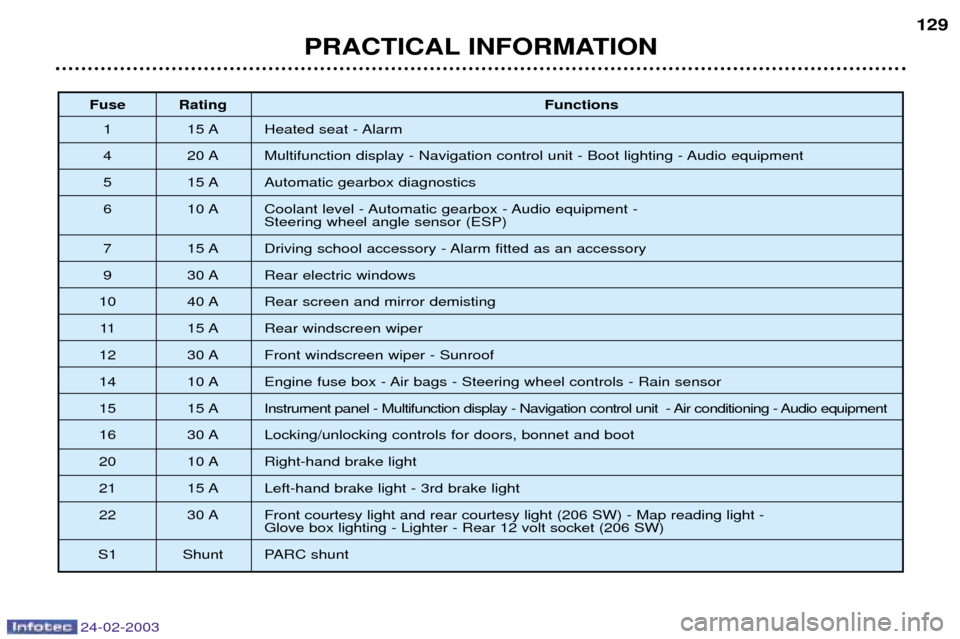
24-02-2003
PRACTICAL INFORMATION129
Fuse Rating
Functions
1 15 A Heated seat - Alarm
4 20 A Multifunction display - Navigation control unit - Boot lighting - Audio equipment
5 15 A Automatic gearbox diagnostics
6 10 A Coolant level - Automatic gearbox - Audio equipment - Steering wheel angle sensor (ESP)
7 15 A Driving school accessory - Alarm fitted as an accessory
9 30 A Rear electric windows
10 40 A Rear screen and mirror demisting
11 15 A Rear windscreen wiper
12 30 A Front windscreen wiper - Sunroof
14 10 A Engine fuse box - Air bags - Steering wheel controls - Rain sensor
15 15 A Instrument panel - Multifunction display - Navigation control unit - Air conditioning - Audio equipment
16 30 A Locking/unlocking controls for doors, bonnet and boot
20 10 A Right-hand brake light
21 15 A Left-hand brake light - 3rd brake light
22 30 A Front courtesy light and rear courtesy light (206 SW) - Map reading light - Glove box lighting - Lighter - Rear 12 volt socket (206 SW)
S1 Shunt PARC shunt
Page 142 of 156
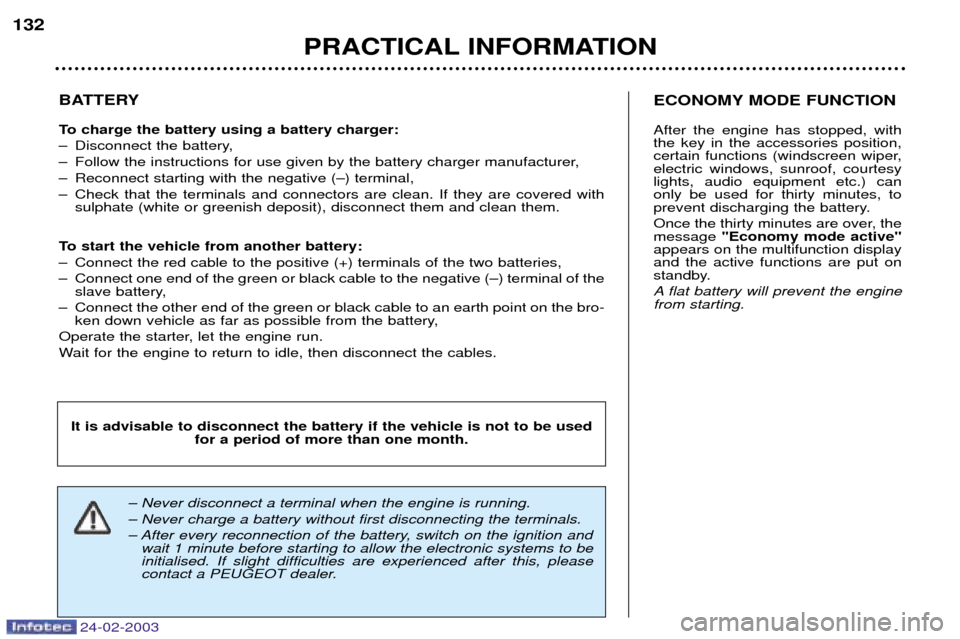
24-02-2003
PRACTICAL INFORMATION
132
BATTERY
To charge the battery using a battery charger:
Ð Disconnect the battery,
Ð Follow the instructions for use given by the battery charger manufacturer,
Ð Reconnect starting with the negative (Ð) terminal,
Ð Check that the terminals and connectors are clean. If they are covered withsulphate (white or greenish deposit), disconnect them and clean them.
To start the vehicle from another battery:
Ð Connect the red cable to the positive (+) terminals of the two batteries,
Ð Connect one end of the green or black cable to the negative (Ð) terminal of the slave battery,
Ð Connect the other end of the green or black cable to an earth point on the bro- ken down vehicle as far as possible from the battery,
Operate the starter, let the engine run.
Wait for the engine to return to idle, then disconnect the cables.
Ð Never disconnect a terminal when the engine is running. Ð Never charge a battery without first disconnecting the terminals.
Ð After every reconnection of the battery, switch on the ignition and wait 1 minute before starting to allow the electronic systems to be initialised. If slight difficulties are experienced after this, please
contact a PEUGEOT dealer.
It is advisable to disconnect the battery if the vehicle is not to be used for a period of more than one month.
ECONOMY MODE FUNCTION After the engine has stopped, with the key in the accessories position,
certain functions (windscreen wiper,electric windows, sunroof, courtesylights, audio equipment etc.) canonly be used for thirty minutes, to
prevent discharging the battery.
Once the thirty minutes are over, the message "Economy mode active"
appears on the multifunction displayand the active functions are put on
standby.
A flat battery will prevent the engine from starting.
Page 143 of 156
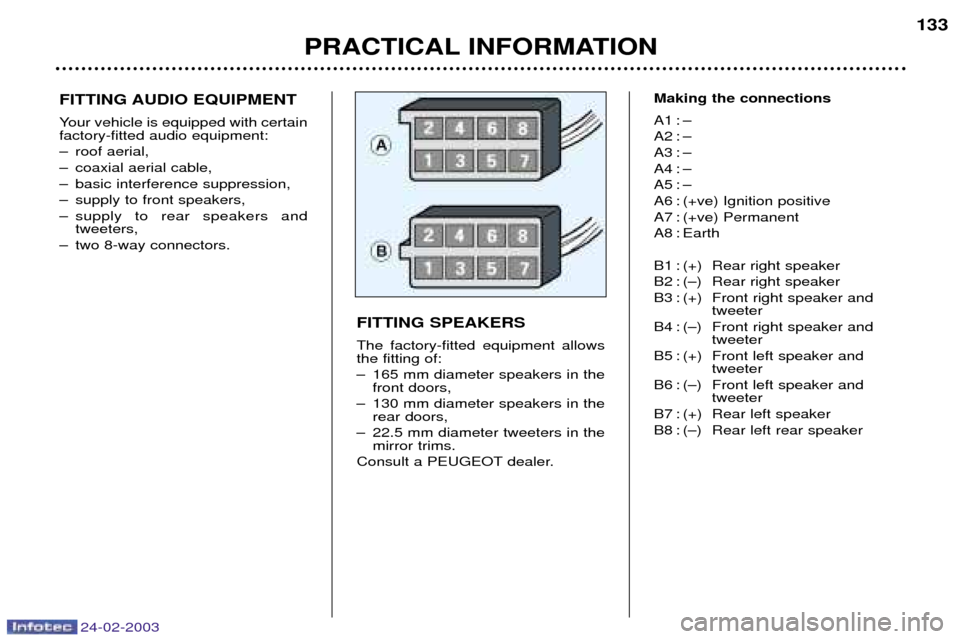
24-02-2003
PRACTICAL INFORMATION133
FITTING AUDIO EQUIPMENT
Your vehicle is equipped with certain factory-fitted audio equipment:
Ð roof aerial,
Ð coaxial aerial cable,
Ð basic interference suppression,
Ð supply to front speakers,
Ð supply to rear speakers and tweeters,
Ð two 8-way connectors. Making the connections
A1 : Ð
A2 : Ð
A3 : Ð
A4 : Ð
A5 : Ð
A6 : (+ve) Ignition positive
A7 : (+ve) Permanent
A8 : Earth
B1 : (+) Rear right speaker
B2 : (Ð) Rear right speaker
B3 : (+) Front right speaker and
tweeter
B4 : (Ð) Front right speaker and tweeter
B5 : (+) Front left speaker and tweeter
B6 : (Ð) Front left speaker and tweeter
B7 : (+) Rear left speaker
B8 : (Ð) Rear left rear speaker
FITTING SPEAKERS The factory-fitted equipment allows the fitting of:
Ð 165 mm diameter speakers in the
front doors,
Ð 130 mm diameter speakers in the rear doors,
Ð 22.5 mm diameter tweeters in the mirror trims.
Consult a PEUGEOT dealer.
Page 144 of 156
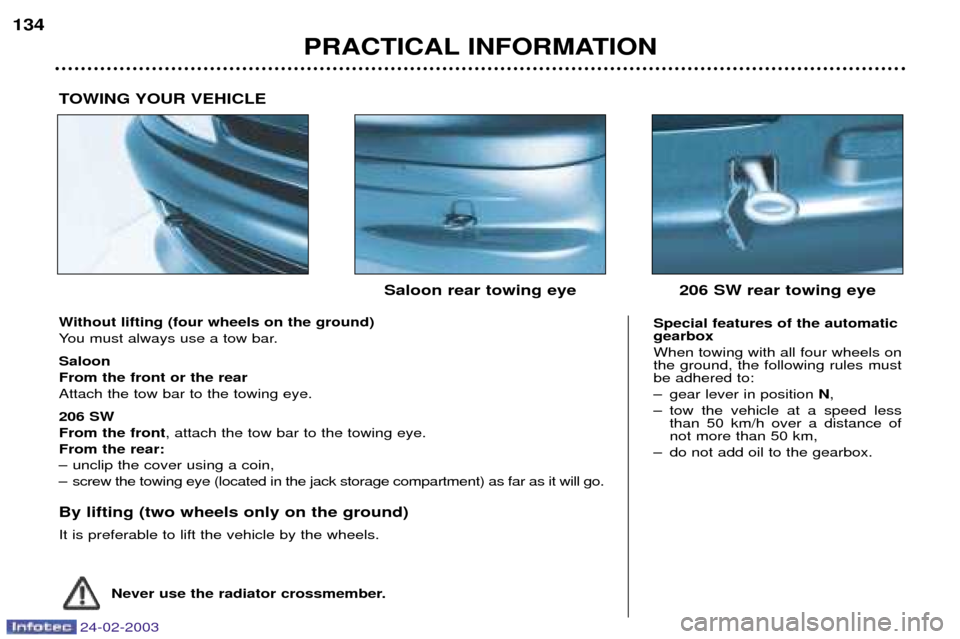
24-02-2003
PRACTICAL INFORMATION
134
Without lifting (four wheels on the ground)
You must always use a tow bar. Saloon From the front or the rearAttach the tow bar to the towing eye. 206 SW From the front , attach the tow bar to the towing eye.
From the rear:
Ð unclip the cover using a coin,
Ð screw the towing eye (located in the jack storage compartment) as far as it will go. By lifting (two wheels only on the ground) It is preferable to lift the vehicle by the wheels.
Special features of the automatic gearbox When towing with all four wheels on the ground, the following rules mustbe adhered to:
Ð gear lever in position N,
Ð tow the vehicle at a speed less than 50 km/h over a distance of not more than 50 km,
Ð do not add oil to the gearbox.
Saloon rear towing eye
206 SW rear towing eye
Never use the radiator crossmember.
TOWING YOUR VEHICLE
Page 145 of 156

24-02-2003
PRACTICAL INFORMATION135
TOWING A TRAILER,
CARAVAN, BOAT etc,
Only use original PEUGEOT tow bars that have been tested andapproved from the design stage of
your vehicle. The tow bar must be
fitted by a PEUGEOT dealer.
Your vehicle is basically designed for transporting people and luggagebut it may also be used for towing a
trailer. Driving with a trailer subjects the towing vehicle to more significantstress and its driver must be particu-larly careful. Air density decreases with altitude, thus reducing engine performance.Above 1 000 metres, the maximumtowing load must be reduced by
10 % and so on for every 1 000metres of altitude. Driving advice Distribution of loads:
distribute the
load in the trailer so that the heavi- est items are as close as possible tothe axle and the nose weightapproaches the maximum permittedwithout exceeding it. Cooling: towing a trailer on a slope
increases the temperature of the
coolant. As the fan is electricallycontrolled, its cooling capacity is notdependent on the engine speed.
On the contrary, use a high gear to lower the engine speed, and reduceyour speed. The maximum towing load on a long slope depends on the gradient andthe outside temperature. In all cases, pay attention to thecoolant temperature. If the warning light comes on, stop
the vehicle and switch off the engineas soon as possible.
Tyres:
check the tyre pressures of
the towing vehicle and of the trailer, observing the recommended pres-sures. Braking: towing increases the brak-
ing distance.Lights: check the electrical sig-
nalling on the trailer.Side wind: take into acount the
increased sensitivity to side wind.
Page 146 of 156
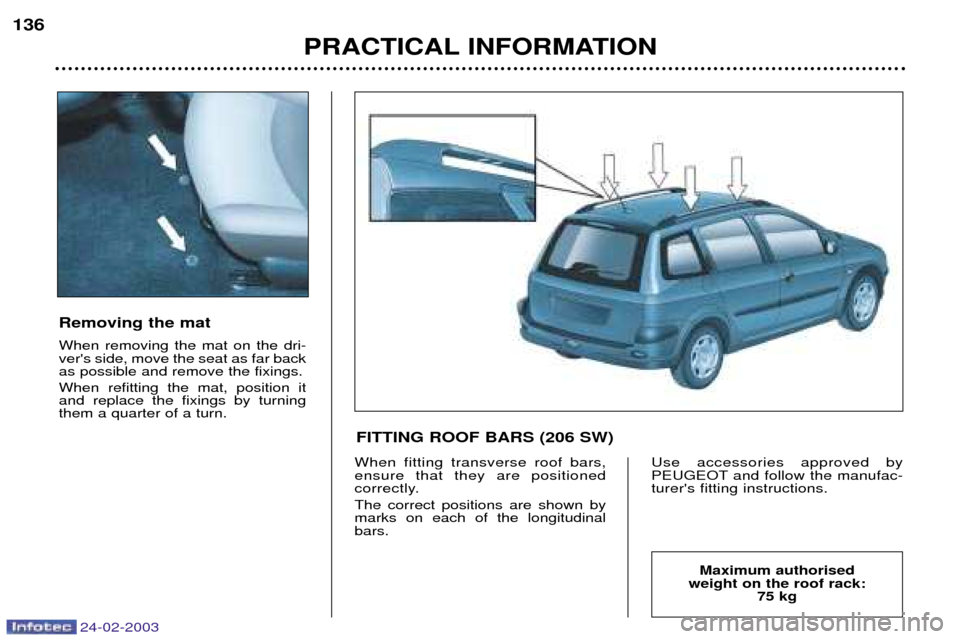
24-02-2003
PRACTICAL INFORMATION
136
Removing the mat When removing the mat on the dri- ver's side, move the seat as far backas possible and remove the fixings. When refitting the mat, position it and replace the fixings by turningthem a quarter of a turn.
When fitting transverse roof bars, ensure that they are positioned
correctly. The correct positions are shown by marks on each of the longitudinalbars. Use accessories approved by
PEUGEOT and follow the manufac-turer's fitting instructions.
Maximum authorised
weight on the roof rack: 75 kg
FITTING ROOF BARS (206 SW)
Page 147 of 156
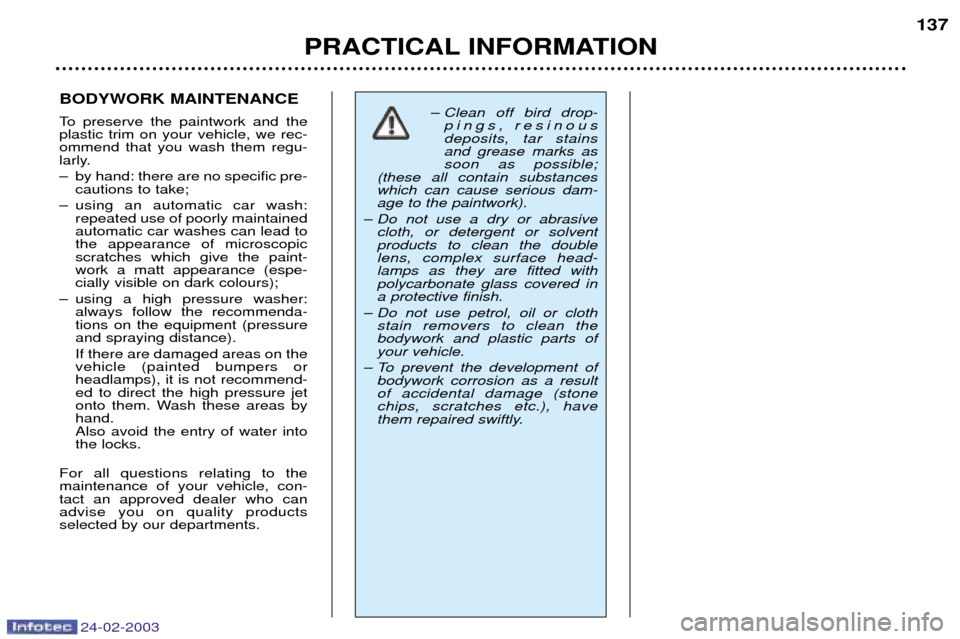
24-02-2003
PRACTICAL INFORMATION137
BODYWORK MAINTENANCE
To preserve the paintwork and the plastic trim on your vehicle, we rec-ommend that you wash them regu-
larly.
Ð by hand: there are no specific pre- cautions to take;
Ð using an automatic car wash: repeated use of poorly maintained automatic car washes can lead tothe appearance of microscopicscratches which give the paint-work a matt appearance (espe-cially visible on dark colours);
Ð using a high pressure washer: always follow the recommenda-tions on the equipment (pressureand spraying distance). If there are damaged areas on the vehicle (painted bumpers orheadlamps), it is not recommend-ed to direct the high pressure jet
onto them. Wash these areas byhand.Also avoid the entry of water intothe locks.
For all questions relating to themaintenance of your vehicle, con-tact an approved dealer who canadvise you on quality productsselected by our departments.
Ð Clean off bird drop- pings, resinous deposits, tar stainsand grease marks assoon as possible;
(these all contain substanceswhich can cause serious dam-age to the paintwork).
Ð Do not use a dry or abrasive cloth, or detergent or solventproducts to clean the doublelens, complex surface head-lamps as they are fitted withpolycarbonate glass covered ina protective finish.
Ð Do not use petrol, oil or cloth stain removers to clean thebodywork and plastic parts ofyour vehicle.
Ð To prevent the development of bodywork corrosion as a resultof accidental damage (stonechips, scratches etc.), have
them repaired swiftly.
Page 148 of 156

24-02-2003
PRACTICAL INFORMATION
138
206 ACCESSORIES
For your PEUGEOT only use accessories and original parts approved by the manufacturer.
These accessories and parts are all adapted to your PEUGEOT, after being tested and approved for reliability and safety,
which PEUGEOT cannot guarantee for other products.
A wide choice of original accessories, approved by PEUGEOT, is available through the dealer network. They all carry the
PEUGEOT guarantee.
Safety : Anti-theft alarms, window engraving, wheel locks, warning triangle, first aid kit...
Protection : Covers compatible with side air bags, carpets, boot tray...
Communication : Audio/telephone, hands-free kit, on-board satellite navigation system, CD changers, radios, speakers, radio trim, rear shelf fitted with 4 speakers (saloon)...
Customising : Alloy wheels, trims, sunroof*, front fog lamps, mud flaps, tailgate spoiler (saloon), sportexhaust, aluminium and wood panel trim, door sills, body kit, wing extenders...
* To fit a sunroof, it is essential that only original PEUGEOT products are used.
Comfort : Centre armrest, writing table, passenger seat protection, large storage box, bottle holder, CD
or cassette storage, telephone console, door deflectors, under shelf storage (saloon)...
Leisure : Tow bar, roof bars, roof boxes, ski carrier, bicycle carrier**, snow chains...
** Do not fit the bicycle carrier on the spoiler or on the rear screen.
Children : Booster seats and child seats, Kiddy Isofix seat, sun blinds...
Maintenance products : Windscreen wash fluid, interior and exterior maintenance and cleaning products...
Va n : Kit for conversion into a van...
Page 149 of 156
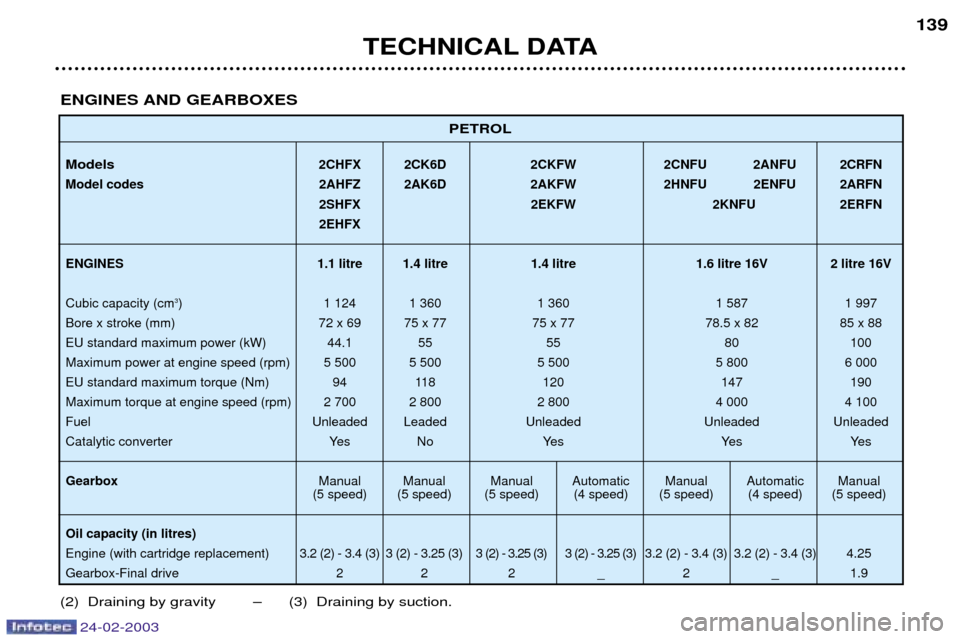
24-02-2003
TECHNICAL DATA139
PETROL
Models2CHFX 2CK6D 2CKFW 2CNFU 2ANFU 2CRFN
Model codes 2AHFZ 2AK6D 2AKFW 2HNFU 2ENFU 2ARFN
2SHFX 2EKFW 2KNFU 2ERFN 2EHFX
ENGINES 1.1 litre 1.4 litre 1.4 litre 1.6 litre 16V 2 litre 16V Cubic capacity (cm 3
) 1 124 1 360 1 360 1 587 1 997
Bore x stroke (mm) 72 x 69 75 x 77 75 x 77 78.5 x 82 85 x 88
EU standard maximum power (kW) 44.1 55 55 80 100
Maximum power at engine speed (rpm) 5 500 5 500 5 500 5 800 6 000
EU standard maximum torque (Nm) 94 118 120 147 190
Maximum torque at engine speed (rpm) 2 700 2 800 2 800 4 000 4 100Fuel Unleaded Leaded Unleaded Unleaded Unleaded
Catalytic converter Yes No Yes Yes Yes Gearbox Manual Manual Manual Automatic Manual Automatic Manual
(5 speed) (5 speed) (5 speed) (4 speed) (5 speed) (4 speed) (5 speed)
Oil capacity (in litres) Engine (with cartridge replacement) 3.2 (2) - 3.4 (3) 3 (2) - 3.25 (3) 3 (2) - 3.25 (3) 3 (2) - 3.25 (3)3.2 (2) - 3.4 (3) 3.2 (2) - 3.4 (3) 4.25
Gearbox-Final drive 2 2 2 _ 2 _ 1.9
ENGINES AND GEARBOXES
(2) Draining by gravity Ð (3) Draining by suction.
Page 150 of 156
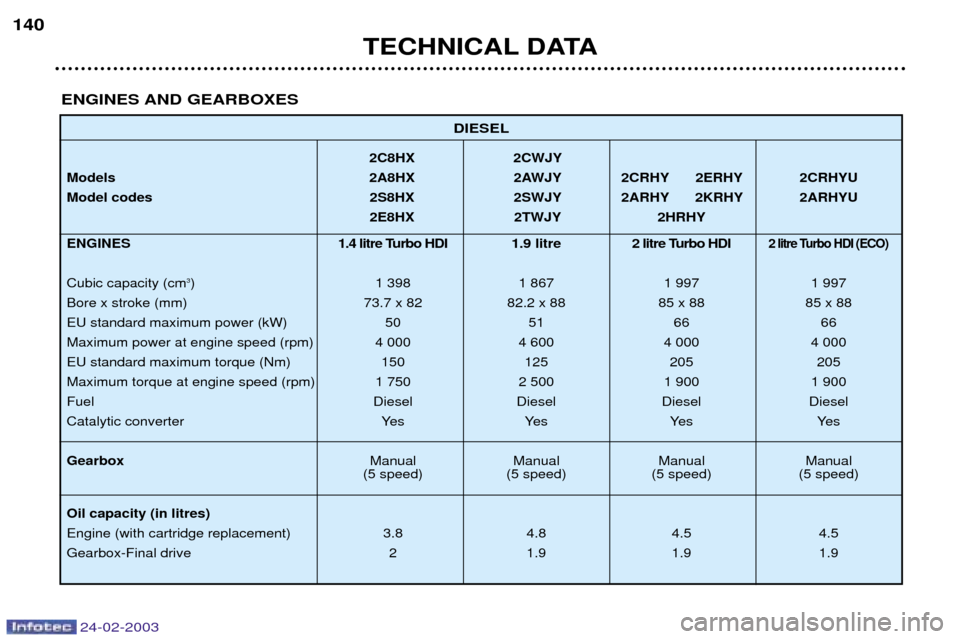
24-02-2003
TECHNICAL DATA
140
DIESEL
2C8HX 2CWJY
Models 2A8HX 2AWJY 2CRHY 2ERHY 2CRHYU
Model codes 2S8HX 2SWJY 2ARHY 2KRHY 2ARHYU 2E8HX 2TWJY 2HRHY
ENGINES 1.4 litre Turbo HDI1.9 litre 2 litre Turbo HDI
2 litre Turbo HDI (ECO)
Cubic capacity (cm3
) 1 398 1 867 1 997 1 997
Bore x stroke (mm) 73.7 x 82 82.2 x 88 85 x 88 85 x 88
EU standard maximum power (kW) 50 51 66 66
Maximum power at engine speed (rpm) 4 000 4 600 4 000 4 000
EU standard maximum torque (Nm) 150 125 205 205
Maximum torque at engine speed (rpm) 1 750 2 500 1 900 1 900Fuel Diesel Diesel Diesel Diesel
Catalytic converter Yes Yes Yes Yes Gearbox Manual Manual Manual Manual
(5 speed) (5 speed) (5 speed) (5 speed)
Oil capacity (in litres)
Engine (with cartridge replacement) 3.8 4.8 4.5 4.5
Gearbox-Final drive 2 1.9 1.9 1.9
ENGINES AND GEARBOXES